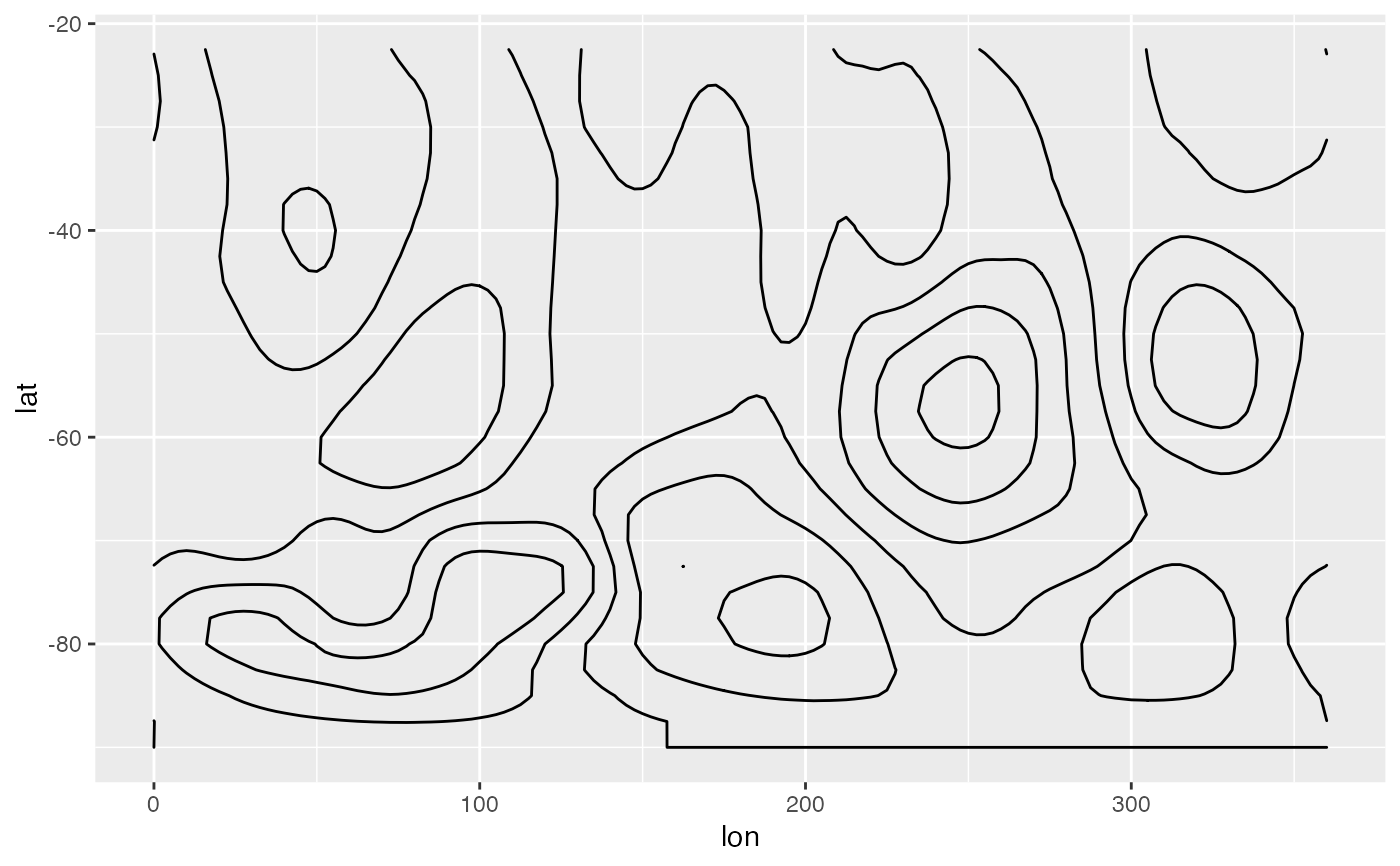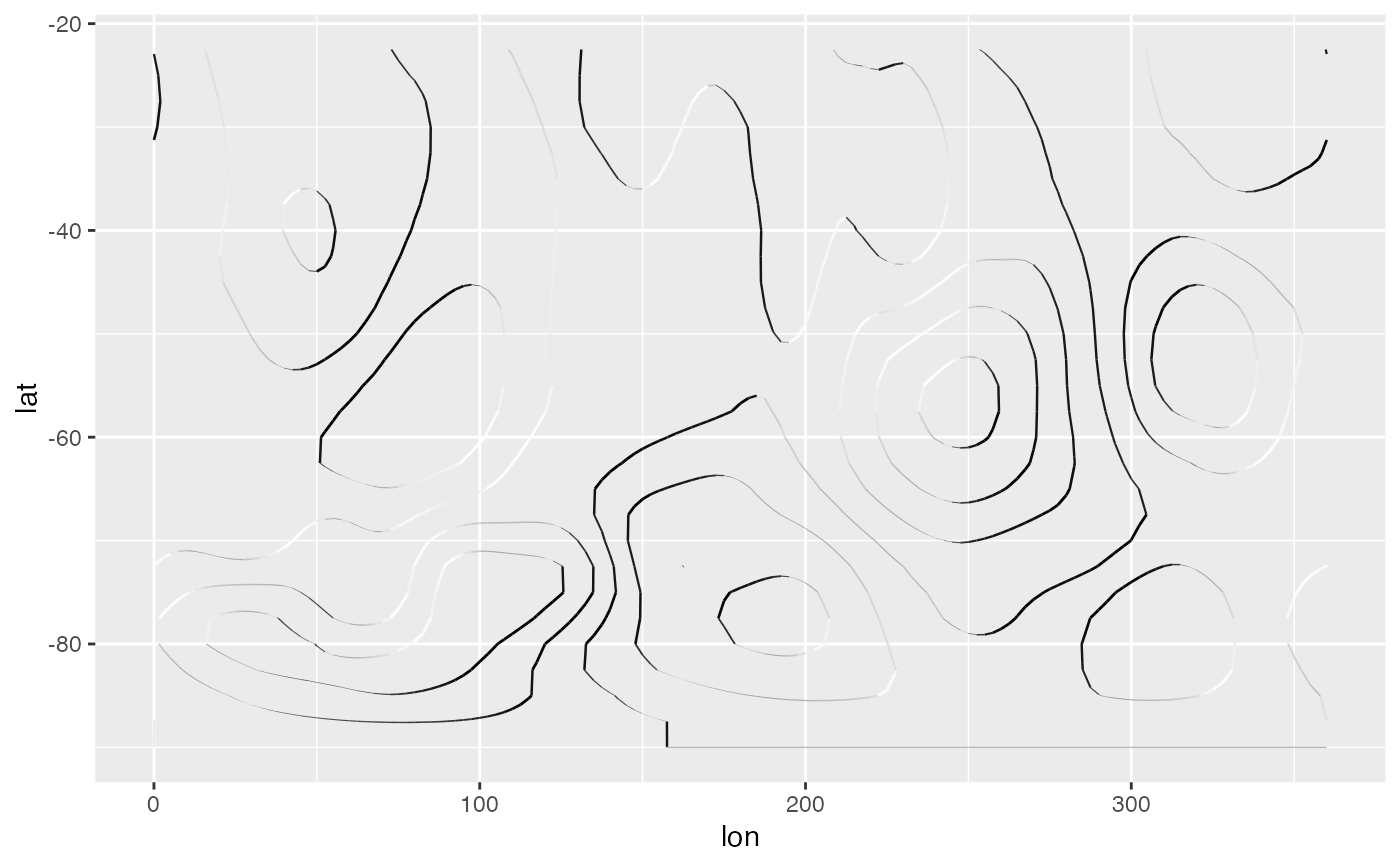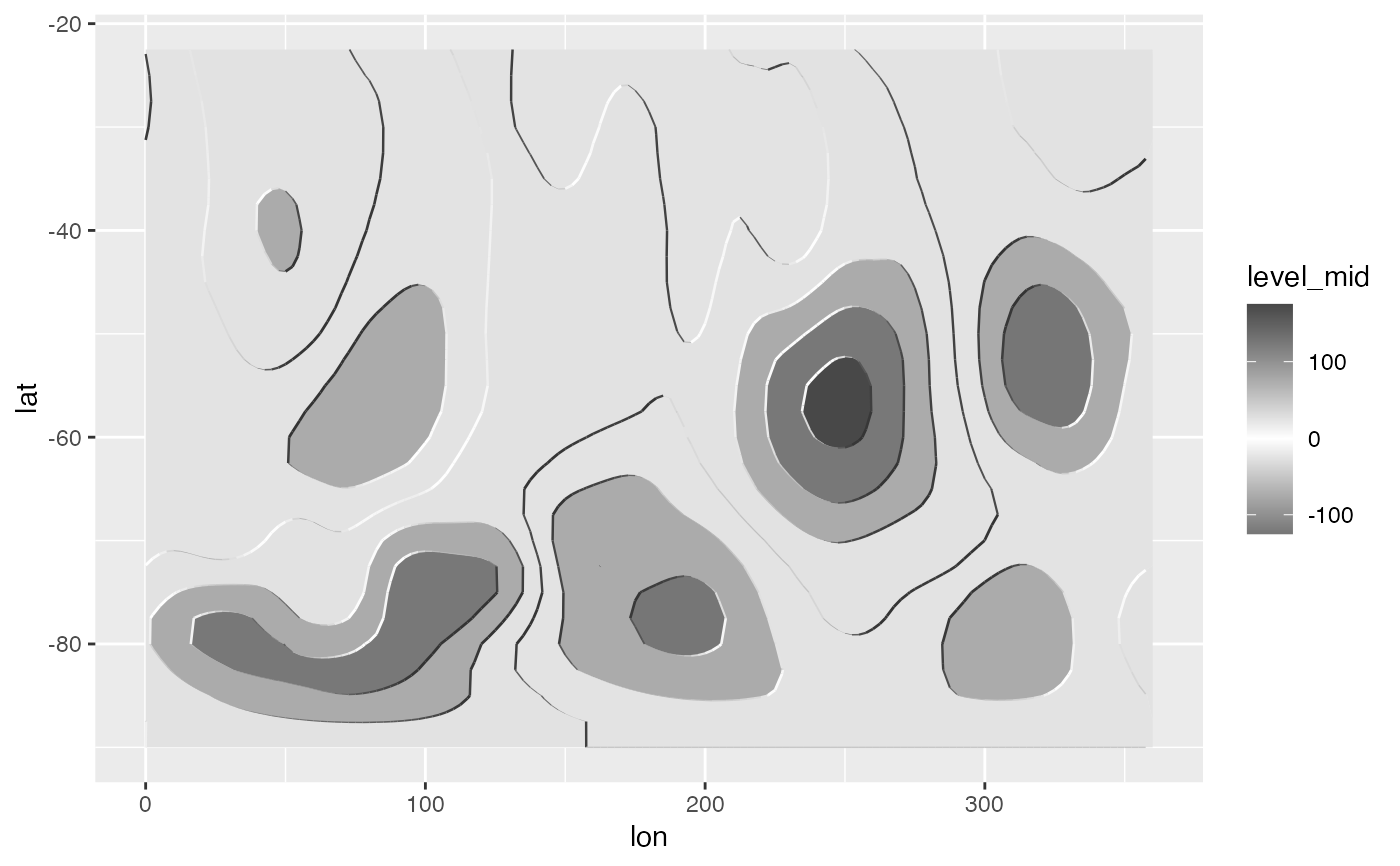Illuminated contours (aka Tanaka contours) use varying brightness and width to create an illusion of relief. This can help distinguishing between concave and convex areas (local minimums and maximums), specially in black and white plots or to make photocopy safe plots with divergent colour palettes, or to render a more aesthetically pleasing representation of topography.
geom_contour_tanaka(
mapping = NULL,
data = NULL,
stat = "Contour2",
position = "identity",
...,
breaks = NULL,
bins = NULL,
binwidth = NULL,
sun.angle = 60,
light = "white",
dark = "gray20",
range = c(0.01, 0.5),
smooth = 0,
na.rm = FALSE,
show.legend = NA,
inherit.aes = TRUE
)Arguments
- mapping
Set of aesthetic mappings created by
aes(). If specified andinherit.aes = TRUE(the default), it is combined with the default mapping at the top level of the plot. You must supplymappingif there is no plot mapping.- data
The data to be displayed in this layer. There are three options:
If
NULL, the default, the data is inherited from the plot data as specified in the call toggplot().A
data.frame, or other object, will override the plot data. All objects will be fortified to produce a data frame. Seefortify()for which variables will be created.A
functionwill be called with a single argument, the plot data. The return value must be adata.frame, and will be used as the layer data. Afunctioncan be created from aformula(e.g.~ head(.x, 10)).- stat
The statistical transformation to use on the data for this layer, either as a
ggprotoGeomsubclass or as a string naming the stat stripped of thestat_prefix (e.g."count"rather than"stat_count")- position
Position adjustment, either as a string naming the adjustment (e.g.
"jitter"to useposition_jitter), or the result of a call to a position adjustment function. Use the latter if you need to change the settings of the adjustment.- ...
Other arguments passed on to
layer(). These are often aesthetics, used to set an aesthetic to a fixed value, likecolour = "red"orsize = 3. They may also be parameters to the paired geom/stat.- breaks
One of:
A numeric vector of breaks
A function that takes the range of the data and binwidth as input and returns breaks as output
- bins
Number of evenly spaced breaks.
- binwidth
Distance between breaks.
- sun.angle
angle of the sun in degrees counterclockwise from 12 o' clock
- light, dark
valid colour representing the light and dark shading
- range
numeric vector of length 2 with the minimum and maximum size of lines
- smooth
numeric indicating the degree of smoothing of illumination and size. Larger
- na.rm
If
FALSE, the default, missing values are removed with a warning. IfTRUE, missing values are silently removed.- show.legend
logical. Should this layer be included in the legends?
NA, the default, includes if any aesthetics are mapped.FALSEnever includes, andTRUEalways includes. It can also be a named logical vector to finely select the aesthetics to display.- inherit.aes
If
FALSE, overrides the default aesthetics, rather than combining with them. This is most useful for helper functions that define both data and aesthetics and shouldn't inherit behaviour from the default plot specification, e.g.borders().
Aesthetics
geom_contour_tanaka understands the following aesthetics (required aesthetics are in bold)
x
y
z
linetype
Examples
library(ggplot2)
library(data.table)
# A fresh look at the boring old volcano dataset
ggplot(reshape2::melt(volcano), aes(Var1, Var2)) +
geom_contour_fill(aes(z = value)) +
geom_contour_tanaka(aes(z = value)) +
theme_void()
 # If the transition between segments feels too abrupt,
# smooth it a bit with smooth
ggplot(reshape2::melt(volcano), aes(Var1, Var2)) +
geom_contour_fill(aes(z = value)) +
geom_contour_tanaka(aes(z = value), smooth = 1) +
theme_void()
# If the transition between segments feels too abrupt,
# smooth it a bit with smooth
ggplot(reshape2::melt(volcano), aes(Var1, Var2)) +
geom_contour_fill(aes(z = value)) +
geom_contour_tanaka(aes(z = value), smooth = 1) +
theme_void()
 data(geopotential)
geo <- geopotential[date == unique(date)[4]]
geo[, gh.z := Anomaly(gh), by = lat]
#> lon lat lev gh date gh.z
#> 1: 0.0 -22.5 700 3150.467 1990-04-01 -0.5528954
#> 2: 2.5 -22.5 700 3146.000 1990-04-01 -5.0194482
#> 3: 5.0 -22.5 700 3141.833 1990-04-01 -9.1861962
#> 4: 7.5 -22.5 700 3139.467 1990-04-01 -11.5528954
#> 5: 10.0 -22.5 700 3139.967 1990-04-01 -11.0528954
#> ---
#> 4028: 347.5 -90.0 700 2696.433 1990-04-01 0.0000000
#> 4029: 350.0 -90.0 700 2696.433 1990-04-01 0.0000000
#> 4030: 352.5 -90.0 700 2696.433 1990-04-01 0.0000000
#> 4031: 355.0 -90.0 700 2696.433 1990-04-01 0.0000000
#> 4032: 357.5 -90.0 700 2696.433 1990-04-01 0.0000000
# In a monochrome contour map, it's impossible to know which areas are
# local maximums or minimums.
ggplot(geo, aes(lon, lat)) +
geom_contour2(aes(z = gh.z), color = "black", xwrap = c(0, 360))
#> Warning: 'xwrap' and 'ywrap' will be deprecated. Use ggperiodic::periodic insead.
data(geopotential)
geo <- geopotential[date == unique(date)[4]]
geo[, gh.z := Anomaly(gh), by = lat]
#> lon lat lev gh date gh.z
#> 1: 0.0 -22.5 700 3150.467 1990-04-01 -0.5528954
#> 2: 2.5 -22.5 700 3146.000 1990-04-01 -5.0194482
#> 3: 5.0 -22.5 700 3141.833 1990-04-01 -9.1861962
#> 4: 7.5 -22.5 700 3139.467 1990-04-01 -11.5528954
#> 5: 10.0 -22.5 700 3139.967 1990-04-01 -11.0528954
#> ---
#> 4028: 347.5 -90.0 700 2696.433 1990-04-01 0.0000000
#> 4029: 350.0 -90.0 700 2696.433 1990-04-01 0.0000000
#> 4030: 352.5 -90.0 700 2696.433 1990-04-01 0.0000000
#> 4031: 355.0 -90.0 700 2696.433 1990-04-01 0.0000000
#> 4032: 357.5 -90.0 700 2696.433 1990-04-01 0.0000000
# In a monochrome contour map, it's impossible to know which areas are
# local maximums or minimums.
ggplot(geo, aes(lon, lat)) +
geom_contour2(aes(z = gh.z), color = "black", xwrap = c(0, 360))
#> Warning: 'xwrap' and 'ywrap' will be deprecated. Use ggperiodic::periodic insead.
 # With tanaka contours, they are obvious.
ggplot(geo, aes(lon, lat)) +
geom_contour_tanaka(aes(z = gh.z), dark = "black",
xwrap = c(0, 360)) +
scale_fill_divergent()
#> Warning: 'xwrap' and 'ywrap' will be deprecated. Use ggperiodic::periodic insead.
# With tanaka contours, they are obvious.
ggplot(geo, aes(lon, lat)) +
geom_contour_tanaka(aes(z = gh.z), dark = "black",
xwrap = c(0, 360)) +
scale_fill_divergent()
#> Warning: 'xwrap' and 'ywrap' will be deprecated. Use ggperiodic::periodic insead.
 # A good divergent color palette has the same luminosity for positive
# and negative values.But that means that printed in grayscale (Desaturated),
# they are indistinguishable.
(g <- ggplot(geo, aes(lon, lat)) +
geom_contour_fill(aes(z = gh.z), xwrap = c(0, 360)) +
scale_fill_gradientn(colours = c("#767676", "white", "#484848"),
values = c(0, 0.415, 1)))
#> Warning: 'xwrap' and 'ywrap' will be deprecated. Use ggperiodic::periodic insead.
# A good divergent color palette has the same luminosity for positive
# and negative values.But that means that printed in grayscale (Desaturated),
# they are indistinguishable.
(g <- ggplot(geo, aes(lon, lat)) +
geom_contour_fill(aes(z = gh.z), xwrap = c(0, 360)) +
scale_fill_gradientn(colours = c("#767676", "white", "#484848"),
values = c(0, 0.415, 1)))
#> Warning: 'xwrap' and 'ywrap' will be deprecated. Use ggperiodic::periodic insead.
 # Tanaka contours can solve this issue.
g + geom_contour_tanaka(aes(z = gh.z))
# Tanaka contours can solve this issue.
g + geom_contour_tanaka(aes(z = gh.z))
